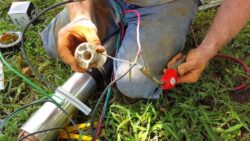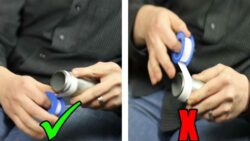In this informative article, you will discover a straightforward and comprehensive guide on how to effectively snake a toilet. Whether you are facing a stubborn clog or simply want to avoid future plumbing issues, this step-by-step tutorial will equip you with the knowledge and techniques needed to clear the blockage with ease. By following these straightforward instructions, you will be able to tackle toilet snaking with confidence and restore the proper functioning of your bathroom fixture. Say goodbye to frustrating clogs and hello to a smoothly running toilet with this simple yet indispensable guide.
Check If Snaking is Necessary
Evaluate the Problem
Before you start snaking your toilet, it’s important to evaluate whether snaking is necessary. If you notice that your toilet is not flushing properly or is draining slowly, it is likely that there is a clog that needs to be cleared. However, it’s important to consider other potential causes of the problem, such as a malfunctioning flush valve or a problem with the plumbing system. If you are unsure about the cause of the issue, it may be helpful to consult a professional plumber.
Look for Signs of a Clog
To determine if snaking is necessary, you can look for signs of a clog in your toilet. Common signs include water backing up and not draining properly, gurgling sounds when flushing, or a foul odor coming from the toilet. If you notice any of these signs, it’s a good indication that there is a clog that needs to be addressed.
Consider Other Methods
While snaking is often an effective method for clearing toilet clogs, it’s worth considering other methods as well. For minor clogs, you may be able to use a plunger to dislodge the blockage. Additionally, there are chemical drain cleaners available on the market that can help dissolve the clog. However, it’s important to use caution when using chemical drain cleaners as they can be harsh and may cause damage to your plumbing system. If you are unsure about the best method to use, it’s best to consult a professional plumber.
Gather the Required Tools
Toilet Auger or Snake
To snake your toilet, you will need a toilet auger or snake. This tool is specifically designed to navigate through the twists and turns of the toilet drain to clear the clog. It has a long flexible cable with a handle at one end and a corkscrew-like attachment at the other end.
Gloves
It is important to protect your hands while snaking the toilet. Wear a pair of gloves to prevent any potential contact with waste or harmful bacteria.
Protective Eyewear
In addition to gloves, it is also a good idea to wear protective eyewear to prevent any splashing or debris from entering your eyes while snaking the toilet.
Bucket or Towels
To minimize any mess, it’s a good idea to have a bucket or towels on hand. This will be useful in case there is any overflow or water spillage during the snaking process.
Prepare the Area
Clear the Surrounding Space
Before you begin snaking your toilet, make sure to clear the surrounding space. Remove any items such as floor mats, trash bins, or toiletries that may obstruct your movement or get in the way during the process. Creating a clear and spacious working area will allow you to work more efficiently and minimize the risk of accidents or damage to nearby objects.
Protect the Bathroom Floor
To protect your bathroom floor from any potential water spillage or damage, lay down towels or use a large plastic sheet to create a barrier. This will help contain any water or waste that may spill during the snaking process, making the cleanup easier and preventing any potential damage to your flooring.
Turn Off the Water Supply
Locate the Water Shut-off Valve
Before you start snaking your toilet, locate the water shut-off valve. This valve is typically located on the wall behind or near the toilet. It is important to know the exact location of the valve, as you will need to turn it off to prevent any water flow while snaking the toilet.
Gently Turn Off the Valve
Once you have located the water shut-off valve, gently turn it clockwise to shut off the water supply to the toilet. This will prevent any accidental flushing or water flow while you are working on snaking the toilet. Turning off the water supply is an important step to avoid any mess or potential water damage.
Position the Snake
Extend the Snake
With the water supply turned off and the surrounding area prepared, it’s time to extend the snake. Hold the handle of the snake firmly and rotate the handle counterclockwise to extend the cable. Continue extending the cable until you have a length that is sufficient to reach the clog in the toilet drain.
Insert the End into the Toilet Drain
Carefully insert the corkscrew-like end of the snake into the toilet drain. Push it in until you feel resistance, indicating that you have reached the clog. Be cautious not to push too forcefully, as this may cause damage to the toilet or plumbing system.
Apply Gentle Pressure
Once the snake is inserted into the toilet drain, apply gentle pressure to the handle. This will help the corkscrew end of the snake penetrate the clog and start breaking it apart. Use steady and controlled movements to avoid causing any additional damage to the toilet or plumbing system.
Snake the Toilet
Rotate the Handle
While applying pressure to the snake, rotate the handle clockwise. This twisting motion helps the corkscrew end of the snake to grab onto the clog and break it apart. Continue rotating the handle while exerting gentle pressure to effectively snake the toilet.
Push the Snake Forward
As you rotate the handle, slowly push the snake forward into the drain. This forward motion will help the snake to navigate through the twists and turns of the toilet drain, effectively clearing the clog. Take your time and be patient to ensure that the snake reaches as far as possible into the drain.
Keep Steady Pressure
While snaking the toilet, maintain steady pressure on the snake. Avoid applying excessive force, as this may cause the snake to become stuck or damage the toilet or plumbing system. Slow and controlled movements with steady pressure will yield the best results.
Continue Snaking and Retracting
As you proceed with snaking the toilet, you may encounter resistance. This is an indication that the snake has reached a tough portion of the clog. To overcome the resistance, continue rotating the handle while applying gentle pressure. If needed, you can also try retracting the snake slightly and then pushing it forward again. Repeat this process until the clog is fully cleared.
Break Up the Clog
Feel for Resistance
While snaking the toilet, you may feel resistance when the snake encounters the clog. This resistance can vary in intensity and can indicate the size or nature of the blockage. Use your judgment to gauge the resistance and adjust your approach accordingly.
Use Gentle Back-and-Forth Motions
To break up the clog, use gentle back-and-forth motions with the snake. This motion will help dislodge the blockage and make it easier for the snake to navigate through the drain. Avoid using excessive force, as this can cause damage to the toilet or plumbing system.
Avoid Excessive Force
It’s important to avoid using excessive force when breaking up a clog. Applying too much pressure can lead to damage to the toilet or plumbing, and it may also cause the snake to become stuck. Take a patient and measured approach, gradually working through the clog with gentle motions.
Flush the Toilet
Turn the Water Supply Back On
Once you have successfully snaked the toilet and cleared the clog, it’s time to turn the water supply back on. Locate the water shut-off valve and turn it counterclockwise to restore the water flow to the toilet.
Test Multiple Flushes
After turning the water supply back on, test the toilet by flushing it multiple times. This will help ensure that the clog has been fully cleared and that the toilet is functioning properly. If you notice any issues or the water is still not flowing as expected, it may be necessary to repeat the snaking process or consult a professional plumber.
Inspect for Proper Drainage
As you test the toilet, pay attention to the drainage. The water should flow smoothly and drain without any backup or slow drainage. If you notice any issues, it may indicate that there is still a partial clog or a problem with the plumbing system that requires further attention.
Clean Up
Remove the Snake
Once you have successfully snaked the toilet and verified that it is working properly, carefully remove the snake from the toilet drain. Be cautious not to handle the corkscrew end of the snake directly to avoid coming into contact with any waste or harmful bacteria. Gently coil the snake back into its resting position.
Clean and Sanitize the Snake
After removing the snake, it’s important to clean and sanitize it. Rinse the snake thoroughly with water to remove any debris or waste. You can also use a disinfectant solution or bleach diluted with water to sanitize the snake. Once cleaned and sanitized, allow the snake to dry completely before storing it.
Dispose of Waste Properly
Dispose of any waste that may have come out during the snaking process in a proper manner. It is recommended to use disposable gloves and a plastic bag for hygienic disposal. Seal the bag securely and dispose of it in a garbage bin designated for waste.
Prevent Future Clogs
Be Mindful of What You Flush
To prevent future clogs, it is important to be mindful of what you flush down the toilet. Avoid flushing large amounts of toilet paper, feminine hygiene products, or any other items that are not meant to be flushed. Dispose of these items in the trash to avoid potential clogs and damage to your plumbing system.
Install a Toilet Plunger
Having a toilet plunger on hand is a useful preventive measure against future clogs. A plunger can be effective in dislodging minor clogs and keeping your toilet draining smoothly. Ensure that you choose a plunger specifically designed for toilets, as they are designed to create the necessary suction for clearing clogs in toilet drains.
Regularly Maintain the Toilet
Regular maintenance is crucial for preventing future toilet clogs. Make sure to clean the toilet regularly using appropriate cleaning products to prevent the buildup of mineral deposits or any organic matter that may lead to clogs. Inspect the toilet’s components, such as the flush valve and fill valve, for any signs of wear or malfunction and address any issues promptly.
By following these step-by-step instructions, you can effectively snake a toilet and clear any clogs that may be causing drainage problems. Remember to take necessary precautions, such as wearing gloves and protective eyewear, and to use gentle and controlled motions to avoid causing damage to your toilet or plumbing system. With proper maintenance and preventive measures, you can keep your toilet functioning properly and avoid future clogs.





